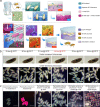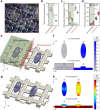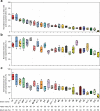Cryopreservation method for Drosophila melanogaster embryos
- PMID: 33893303
- PMCID: PMC8065140
- DOI: 10.1038/s41467-021-22694-z
Cryopreservation method for Drosophila melanogaster embryos
Abstract
The development of a widely adopted cryopreservation method remains a major challenge in Drosophila research. Here we report a robust and easily implemented cryopreservation protocol of Drosophila melanogaster embryos. We present innovations for embryo permeabilization, cryoprotectant agent loading, and rewarming. We show that the protocol is broadly applicable, successfully implemented in 25 distinct strains from different sources. We demonstrate that for most strains, >50% embryos hatch and >25% of the resulting larvae develop into adults after cryopreservation. We determine that survival can be significantly improved by outcrossing to mitigate the effect of genetic background for strains with low survival after cryopreservation. We show that flies retain normal sex ratio, fertility, and original mutation after successive cryopreservation of 5 generations and 6-month storage in liquid nitrogen. Lastly, we find that non-specialists are able to use this protocol to obtain consistent results, demonstrating potential for wide adoption.
Conflict of interest statement
L.Z., M.L., T.H. and J.B. have provisional patent applications (Serial No. 63/136,366) relevant to this study. The authors declare competing interests.
Figures




Similar articles
-
Cryopreservation of Musca domestica (Diptera: Muscidae) embryos.Cryobiology. 2000 Sep;41(2):153-66. doi: 10.1006/cryo.2000.2278. Cryobiology. 2000. PMID: 11034794
-
Vitrification of manually stage-selected embryos of Drosophila have significantly higher survival and emergence - Consequences for insect germplasm storage.Cryobiology. 2022 Apr;105:83-87. doi: 10.1016/j.cryobiol.2022.01.002. Epub 2022 Jan 13. Cryobiology. 2022. PMID: 35032470
-
Cryobiological preservation of Drosophila embryos.Science. 1992 Dec 18;258(5090):1932-5. doi: 10.1126/science.1470915. Science. 1992. PMID: 1470915
-
Efficacy of fish embryo vitrification protocols in terms of embryo morphology - a systematic review.Cryo Letters. 2014 Sep-Oct;35(5):361-70. Cryo Letters. 2014. PMID: 25397950
-
Parasite cryopreservation by vitrification.Cryobiology. 2004 Dec;49(3):201-10. doi: 10.1016/j.cryobiol.2004.09.002. Cryobiology. 2004. PMID: 15615606 Review.
Cited by
-
Ice formation and its elimination in cryopreservation of oocytes.Sci Rep. 2024 Aug 13;14(1):18809. doi: 10.1038/s41598-024-69528-8. Sci Rep. 2024. PMID: 39138273 Free PMC article.
-
Permeability and Toxicity of Cryoprotective Agents in Silkworm Embryos: Impact on Cryopreservation.Int J Mol Sci. 2024 Oct 23;25(21):11396. doi: 10.3390/ijms252111396. Int J Mol Sci. 2024. PMID: 39518950 Free PMC article.
-
An Effective Chemical Permeabilization of Silkworm Embryos.Bioengineering (Basel). 2023 May 8;10(5):563. doi: 10.3390/bioengineering10050563. Bioengineering (Basel). 2023. PMID: 37237633 Free PMC article.
-
High-throughput genetic manipulation of multicellular organisms using a machine-vision guided embryonic microinjection robot.Genetics. 2024 Apr 3;226(4):iyae025. doi: 10.1093/genetics/iyae025. Genetics. 2024. PMID: 38373262 Free PMC article.
-
Offspring production from cryopreserved primordial germ cells in Drosophila.Commun Biol. 2021 Oct 7;4(1):1159. doi: 10.1038/s42003-021-02692-z. Commun Biol. 2021. PMID: 34621004 Free PMC article.
References
Publication types
MeSH terms
Substances
Grants and funding
LinkOut - more resources
Full Text Sources
Other Literature Sources
Molecular Biology Databases

